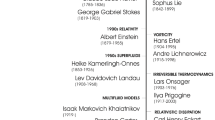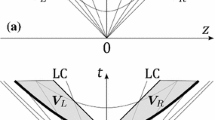Abstract
Dissipative relativistic fluid dynamics is not always causal and can favor super-luminal signal propagation under certain circumstances. On the other hand, high-energy nuclear collisions have a microscopic description in terms of QCD and are expected to follow the causality principle of special relativity. We discuss under which conditions the fluid evolution equations for a radial expansion are hyperbolic and that terms of second order in the Knudsen number are problematic for causality. We also outline briefly how this can be remedied with terms of higher order in a formal derivative expansion. The expansion dynamics are causal in the relativistic sense if the characteristic velocities are smaller than the speed of light. We obtain a concrete inequality from this constraint and discuss how it can be violated for certain initial conditions. Finally we argue that causality poses a bound on the applicability of relativistic fluid dynamics.
Article PDF
Similar content being viewed by others
Avoid common mistakes on your manuscript.
References
U. Heinz and R. Snellings, Collective flow and viscosity in relativistic heavy-ion collisions, Ann. Rev. Nucl. Part. Sci. 63 (2013) 123 [arXiv:1301.2826] [INSPIRE].
C. Gale, S. Jeon and B. Schenke, Hydrodynamic modeling of heavy-ion collisions, Int. J. Mod. Phys. A 28 (2013) 1340011 [arXiv:1301.5893] [INSPIRE].
P. Huovinen, Hydrodynamics at RHIC and LHC: what have we learned?, Int. J. Mod. Phys. E 22 (2013) 1330029 [arXiv:1311.1849] [INSPIRE].
R. Derradi de Souza, T. Koide and T. Kodama, Hydrodynamic approaches in relativistic heavy ion reactions, Prog. Part. Nucl. Phys. 86 (2016) 35 [arXiv:1506.03863] [INSPIRE].
T. Schäfer and D. Teaney, Nearly perfect fluidity: from cold atomic gases to hot quark gluon plasmas, Rept. Prog. Phys. 72 (2009) 126001 [arXiv:0904.3107] [INSPIRE].
I. Muller, Zum Paradoxon der Warmeleitungstheorie (in German), Z. Phys. 198 (1967) 329 [INSPIRE].
W. Israel and J.M. Stewart, Transient relativistic thermodynamics and kinetic theory, Annals Phys. 118 (1979) 341 [INSPIRE].
A. Muronga, Causal theories of dissipative relativistic fluid dynamics for nuclear collisions, Phys. Rev. C 69 (2004) 034903 [nucl-th/0309055] [INSPIRE].
G.S. Denicol, H. Niemi, E. Molnar and D.H. Rischke, Derivation of transient relativistic fluid dynamics from the Boltzmann equation, Phys. Rev. D 85 (2012) 114047 [Erratum ibid. D 91 (2015)039902] [arXiv:1202.4551] [INSPIRE].
J.M. Maldacena, The large N limit of superconformal field theories and supergravity, Int. J. Theor. Phys. 38 (1999) 1113 [hep-th/9711200] [INSPIRE].
R. Baier, P. Romatschke, D.T. Son, A.O. Starinets and M.A. Stephanov, Relativistic viscous hydrodynamics, conformal invariance and holography, JHEP 04 (2008) 100 [arXiv:0712.2451] [INSPIRE].
S. Bhattacharyya, V.E. Hubeny, S. Minwalla and M. Rangamani, Nonlinear fluid dynamics from gravity, JHEP 02 (2008) 045 [arXiv:0712.2456] [INSPIRE].
G. Policastro, D.T. Son and A.O. Starinets, The shear viscosity of strongly coupled N = 4 supersymmetric Yang-Mills plasma, Phys. Rev. Lett. 87 (2001) 081601 [hep-th/0104066] [INSPIRE].
P. Kovtun, D.T. Son and A.O. Starinets, Viscosity in strongly interacting quantum field theories from black hole physics, Phys. Rev. Lett. 94 (2005) 111601 [hep-th/0405231] [INSPIRE].
P. Romatschke, Relativistic viscous fluid dynamics and non-equilibrium entropy, Class. Quant. Grav. 27 (2010) 025006 [arXiv:0906.4787] [INSPIRE].
F.M. Haehl, R. Loganayagam and M. Rangamani, The eightfold way to dissipation, Phys. Rev. Lett. 114 (2015) 201601 [arXiv:1412.1090] [INSPIRE].
F.M. Haehl, R. Loganayagam and M. Rangamani, Adiabatic hydrodynamics: the eightfold way to dissipation, JHEP 05 (2015) 060 [arXiv:1502.00636] [INSPIRE].
M.P. Heller and M. Spalinski, Hydrodynamics beyond the gradient expansion: resurgence and resummation, Phys. Rev. Lett. 115 (2015) 072501 [arXiv:1503.07514] [INSPIRE].
G.S. Denicol and J. Noronha, Divergence of the Chapman-Enskog expansion in relativistic kinetic theory, arXiv:1608.07869 [INSPIRE].
W. Florkowski, M.P. Heller and M. Spalinski, New theories of relativistic hydrodynamics in the LHC era, Rept. Prog. Phys. 81 (2018) 046001 [arXiv:1707.02282] [INSPIRE].
P. Romatschke, Relativistic hydrodynamic attractors with broken symmetries: non-conformal and non-homogeneous, JHEP 12 (2017) 079 [arXiv:1710.03234] [INSPIRE].
P. Romatschke and U. Romatschke, Relativistic fluid dynamics in and out of equilibrium — ten years of progress in theory and numerical simulations of nuclear collisions, arXiv:1712.05815 [INSPIRE].
P. Kostadt and M. Liu, Causality and stability of the relativistic diffusion equation, Phys. Rev. D 62 (2000) 023003 [INSPIRE].
L. Herrera and D. Pavon, Why hyperbolic theories of dissipation cannot be ignored: comments on a paper by Kostadt and Liu, Phys. Rev. D 64 (2001) 088503 [gr-qc/0102026] [INSPIRE].
P. Kostadt and M. Liu, Alleged acausality of the diffusion equations: a reply, Phys. Rev. D 64 (2001) 088504 [INSPIRE].
W.A. Hiscock and L. Lindblom, Stability and causality in dissipative relativistic fluids, Annals Phys. 151 (1983) 466 [INSPIRE].
G.S. Denicol, T. Kodama, T. Koide and P. Mota, Stability and causality in relativistic dissipative hydrodynamics, J. Phys. G 35 (2008) 115102 [arXiv:0807.3120] [INSPIRE].
S. Pu, T. Koide and D.H. Rischke, Does stability of relativistic dissipative fluid dynamics imply causality?, Phys. Rev. D 81 (2010) 114039 [arXiv:0907.3906] [INSPIRE].
R.P. Geroch and L. Lindblom, Dissipative relativistic fluid theories of divergence type, Phys. Rev. D 41 (1990) 1855 [INSPIRE].
G.D. Moore and K.A. Sohrabi, Kubo formulae for second-order hydrodynamic coefficients, Phys. Rev. Lett. 106 (2011) 122302 [arXiv:1007.5333] [INSPIRE].
G.D. Moore and K.A. Sohrabi, Thermodynamical second-order hydrodynamic coefficients, JHEP 11 (2012) 148 [arXiv:1210.3340] [INSPIRE].
R. Penrose, Conformal treatment of infinity, in Relativité, Groupes et Topologie: proceedings, Ecole d’été de Physique Théorique, Session XIII, Les Houches, France, 1 July-24 August 1963 [Gen. Rel. Grav. 43 (2011) 901] [INSPIRE].
R. Courant and D. Hilbert, Methods of mathematical physics, volume II, Interscience Publishers, New York, U.S.A., (1962).
L. Rezzolla and O. Zanotti, Relativistic hydrodynamics, Oxford University Press, Oxford, U.K., (2013) [ISBN-10:0198528906] [ISBN-13:978-0198528906].
S. Borsányi et al., Calculation of the axion mass based on high-temperature lattice quantum chromodynamics, Nature 539 (2016) 69 [arXiv:1606.07494] [INSPIRE].
N. Christiansen, M. Haas, J.M. Pawlowski and N. Strodthoff, Transport coefficients in Yang-Mills theory and QCD, Phys. Rev. Lett. 115 (2015) 112002 [arXiv:1411.7986] [INSPIRE].
Z. Qiu, C. Shen and U. Heinz, Hydrodynamic elliptic and triangular flow in Pb-Pb collisions at \( \sqrt{s} = 2.76A \) TeV, Phys. Lett. B 707 (2012) 151 [arXiv:1110.3033] [INSPIRE].
I. Aniceto and M. Spalinski, Resurgence in extended hydrodynamics, Phys. Rev. D 93 (2016) 085008 [arXiv:1511.06358] [INSPIRE].
G. Basar and G.V. Dunne, Hydrodynamics, resurgence and transasymptotics, Phys. Rev. D 92 (2015) 125011 [arXiv:1509.05046] [INSPIRE].
A. Buchel, M.P. Heller and J. Noronha, Entropy production, hydrodynamics and resurgence in the primordial quark-gluon plasma from holography, Phys. Rev. D 94 (2016) 106011 [arXiv:1603.05344] [INSPIRE].
W. Florkowski, R. Ryblewski and M. Spalinski, Gradient expansion for anisotropic hydrodynamics, Phys. Rev. D 94 (2016) 114025 [arXiv:1608.07558] [INSPIRE].
M. Spalinski, On the hydrodynamic attractor of Yang-Mills plasma, Phys. Lett. B 776 (2018) 468 [arXiv:1708.01921] [INSPIRE].
M. Strickland, J. Noronha and G. Denicol, Anisotropic nonequilibrium hydrodynamic attractor, Phys. Rev. D 97 (2018) 036020 [arXiv:1709.06644] [INSPIRE].
G.S. Denicol and J. Noronha, Analytical attractor and the divergence of the slow-roll expansion in relativistic hydrodynamics, Phys. Rev. D 97 (2018) 056021 [arXiv:1711.01657] [INSPIRE].
M.P. Heller and V. Svensson, How does relativistic kinetic theory remember about initial conditions?, arXiv:1802.08225 [INSPIRE].
G.S. Denicol and J. Noronha, Hydrodynamic attractor and the fate of perturbative expansions in Gubser flow, arXiv:1804.04771 [INSPIRE].
M. Spalinski, Universal behaviour, transients and attractors in supersymmetric Yang-Mills plasma, Phys. Lett. B 784 (2018) 21 [arXiv:1805.11689] [INSPIRE].
Open Access
This article is distributed under the terms of the Creative Commons Attribution License (CC-BY 4.0), which permits any use, distribution and reproduction in any medium, provided the original author(s) and source are credited.
Author information
Authors and Affiliations
Corresponding author
Additional information
ArXiv ePrint: 1711.06687
Rights and permissions
Open Access This article is licensed under a Creative Commons Attribution 4.0 International License, which permits use, sharing, adaptation, distribution and reproduction in any medium or format, as long as you give appropriate credit to the original author(s) and the source, provide a link to the Creative Commons licence, and indicate if changes were made.
The images or other third party material in this article are included in the article’s Creative Commons licence, unless indicated otherwise in a credit line to the material. If material is not included in the article’s Creative Commons licence and your intended use is not permitted by statutory regulation or exceeds the permitted use, you will need to obtain permission directly from the copyright holder.
To view a copy of this licence, visit https://creativecommons.org/licenses/by/4.0/.
About this article
Cite this article
Floerchinger, S., Grossi, E. Causality of fluid dynamics for high-energy nuclear collisions. J. High Energ. Phys. 2018, 186 (2018). https://doi.org/10.1007/JHEP08(2018)186
Received:
Revised:
Accepted:
Published:
DOI: https://doi.org/10.1007/JHEP08(2018)186




